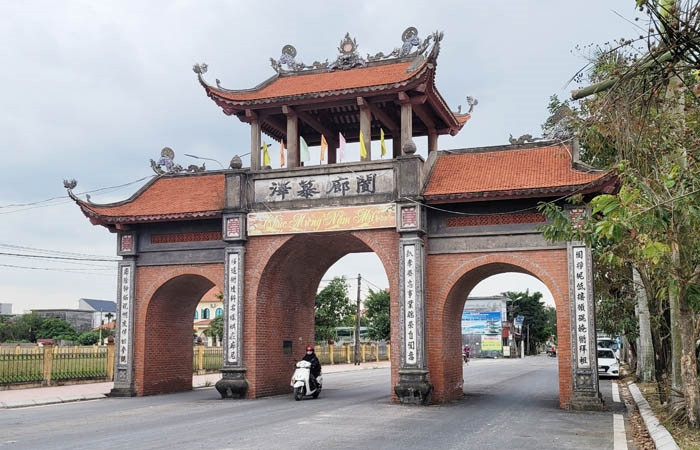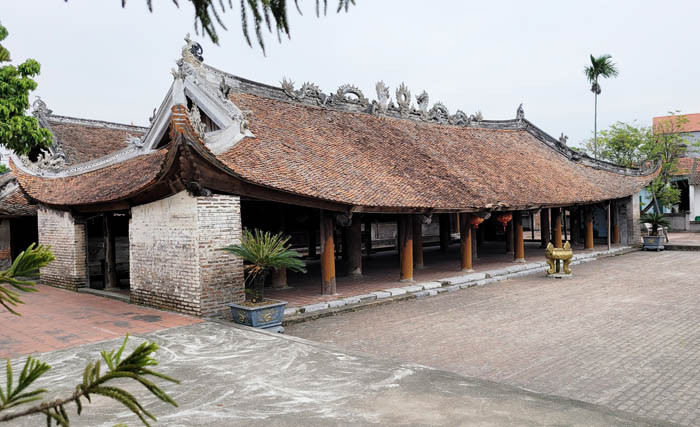Wearing new “clothes” but many rural areas of Hai Duong still keep old countryside’s traditional beauty. Village gates, wells, communal houses, etc. are still familiar in new-style rural villages.

The gate of Mo Trach “doctoral village” in Tan Hong commune, Binh Giang district
Village gate
Vietnamese village gates are close to many people. A village gate is the first point when we arrive in a village and the boundary between villages. It has long been a cultural symbol of each village.
According to historian Tang Ba Hoanh, despite different forms, ancient village gates’ main purpose was to protect villagers from invaders, thieves, and robbers.
Most of ancient citadel-like gates had three doors. The main door was large and high, while the side ones were small and low. On top of each gate was a sentry box.
Ancient Vietnamese villages were arranged with quite strict security precautions and internal defenses; therefore, the French invaders were cautious whenever entering a village, especially for a night raid.
Present-day village gates are relatively different from past ones. Many localities build large gates, most of which are larger and wider to facilitate people's travel. Paint colors and construction materials are also diverse with many patterns suitable to each village. Gates are also decorated with lights for nights or holidays and Tet (Lunar New Year).
Behind each village gate, trenches and guards are no longer needed and replaced with wide concrete roads leading to alleys and sub-hamlets.
To date, there have been not any specific statistics on the number of village gates in the province; however, almost all villages, large or small, have a gate, some even have two.
Coming to numerous rural areas of Hai Duong nowadays, many people still see the special beauty of village gates, such as those in Phu Tinh, Truong Thanh commune, Thanh Ha district; Bang Gia, Tan Viet commune, or Chau Khe, Thuc Khang commune, Binh Giang district; Dong Giao, Luong Dien commune, Cam Giang district; etc.
Communal house

Thach Loi communal house in Thach Loi commune, Cam Giang district, was built in the late 17th century with folk architecture and sculptural patterns
To Vietnamese people, communal houses are sacred places. They often are places to worship villages’ tutelary gods, where dignitaries meet to discuss village affairs or organize sacrifices during festivals.
Communal houses always hold an important position in the spiritual life of Vietnamese people.
A communal house is also one of special structures in each village. According to the provincial Museum’s Relic Conservation Department, hundreds of communal houses in the province still retain ancient architectural features. In which, more than 100 communal houses are national relics, becoming the pride of the provincial culture.
Communal houses are always the pride of people when thinking about their homeland. Returning to a communal house is like returning to the root of their native soil.
Communal houses are also the venues of community cultural activities of rural residents.
The province is one of localities home to many famous and beautiful hundred-year-old communal houses in the North.
Thach Loi communal house in Thach Loi commune, Cam Giang district, is known for its monumental architecture and folk sculptural patterns depicting cultural, artistic, and productive lives of people in the Northern Delta.
Hue Tri communal house in An Phu ward, Kinh Mon provincial town, has a unique square shape.
Nhan Ly communal house in Nam Sach district town bears typical architecture in the 17th century, which is the standard of the traditional carving art.
Nowadays, communal houses are still shared ones and places to preserve and transmit cultural features of indigenous people. Therefore, even though life is more developed and modern, a communal house in each village is always a place to cement the village community.
HAI MINH